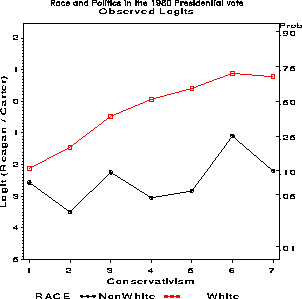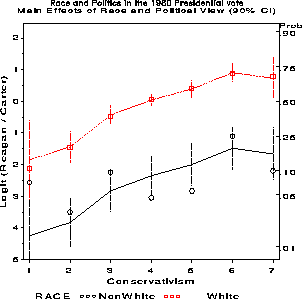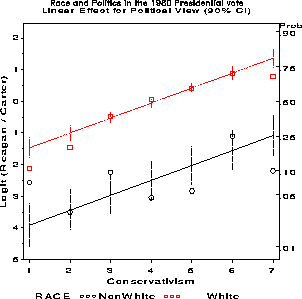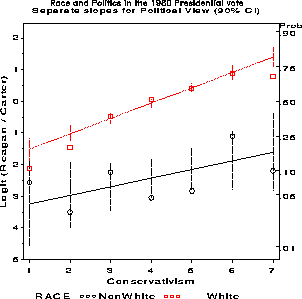A log-linear model expresses the relationship among all variables as a model for the log of the expected cell frequency. For example, for a three-way table, the hypothesis that of no three-way association can be expressed as the log-linear model,
The log-linear model treats the variables symmetrically: none of the variables is distinguished as a response variable. However, the association parameters may be difficult to interpret, and the absence of a dependent variable makes it awkward to plot results in terms of the log-linear model. In this case, correspondence analysis and the mosaic display may provide a simpler way to display the patterns of association in a contingency table.(20)
On the other hand, if one variable can be regarded as a response or dependent variable, and the others as independent variables, then the effects of the independent variables may be expressed as a logit model. For example, if variable C is a binary response, then model (20) can be expressed as an equivalent logit model,
(21)
Both log-linear and logit models can be fit using PROC CATMOD in SAS. For logit models, the steps for fitting a model and plotting the results are similar to those used for logistic models with PROC LOGISTIC. The main differences are:
Political ---- White ---- --- Nonwhite --- View Reagan Carter Reagan Carter 1 1 12 0 6 2 13 57 0 16 3 44 71 2 23 4 155 146 1 31 5 92 61 0 8 6 100 41 2 7 7 18 8 0 4Treating the vote for Reagan vs. Carter or other as the response, a logit model with nominal main effects for race and political view is
This model does not use the ordinal nature of political view. A model which uses the value of political view as a direct, quantitative independent variable can be expressed as(22)
(23)
proc format;
value race 0='NonWhite'
1='White';
data vote;
input @10 race view reagan carter;
format race race.;
reagan= reagan + .5; *-- allow for 0 values;
carter= carter + .5;
total = reagan + carter;
preagan = reagan / total;
logit = log ( reagan / carter);
cards;
White 1 1 1 12
White 1 2 13 57
White 1 3 44 71
White 1 4 155 146
White 1 5 92 61
White 1 6 100 41
White 1 7 18 8
NonWhite 0 1 0 6
NonWhite 0 2 0 16
NonWhite 0 3 2 23
NonWhite 0 4 1 31
NonWhite 0 5 0 8
NonWhite 0 6 2 7
NonWhite 0 7 0 4
;
data votes;
set vote;
votes= reagan; votefor='REAGAN'; output;
votes= carter; votefor='CARTER'; output;
Model (22) is fit using the statements below. The RESPONSE statement is used to produce an output data set, PREDICT, for plotting.
proc catmod data=votes order=data;
weight votes;
response / out=predict;
model votefor = race view / noiter ;
title2 f=duplex h=1.4
'Nominal Main Effects of Race and Political View (90% CI)';
The results of the PROC CATMOD step include:
+-------------------------------------------------------------------+ | | | MAXIMUM-LIKELIHOOD ANALYSIS-OF-VARIANCE TABLE | | | | Source DF Chi-Square Prob | | -------------------------------------------------- | | INTERCEPT 1 43.75 0.0000 | | RACE 1 41.37 0.0000 | | VIEW 6 67.84 0.0000 | | | | LIKELIHOOD RATIO 6 3.45 0.7501 | | | +-------------------------------------------------------------------+
+-------------------------------------------------------------------+ | | | ANALYSIS OF MAXIMUM-LIKELIHOOD ESTIMATES | | | | Standard Chi- | | Effect Parameter Estimate Error Square Prob | | ----------------------------------------------------------- | | INTERCEPT 1 -1.4324 0.2166 43.75 0.0000 | | RACE 2 1.1960 0.1859 41.37 0.0000 | | VIEW 3 -1.6144 0.6551 6.07 0.0137 | | 4 -1.2000 0.2857 17.64 0.0000 | | 5 -0.1997 0.2083 0.92 0.3377 | | 6 0.2779 0.1672 2.76 0.0965 | | 7 0.6291 0.1941 10.51 0.0012 | | 8 1.1433 0.2052 31.03 0.0000 | | | +-------------------------------------------------------------------+The data set PREDICT contains observed ( _OBS_) and predicted ( _PRED_) values, and estimated standard errors. There are 3 observations for each race-view group: logit values have _TYPE_ = 'FUNCTION'; probabilities have _TYPE_ = 'PROB'.
+-------------------------------------------------------------------+ | | | RACE VIEW _TYPE_ _NUMBER_ _OBS_ _PRED_ _SEPRED_ | | | | White 1 FUNCTION 1 -2.120 -1.851 0.758 | | White 1 PROB 1 0.107 0.136 0.089 | | White 1 PROB 2 0.893 0.864 0.089 | | White 2 FUNCTION 1 -1.449 -1.437 0.297 | | White 2 PROB 1 0.190 0.192 0.046 | | White 2 PROB 2 0.810 0.808 0.046 | | ... | | | +-------------------------------------------------------------------+To plot the fitted logits, select the _TYPE_ = 'FUNCTION' observations in a data step.
data predict; set predict; if _type_ = 'FUNCTION';A simple plot of predicted logits can then be obtained with the following PROC GPLOT step. (The plots displayed use the Annotate facility to add 90% confidence limits, calculated as _pred_ ± 1.645 _sepred_ , and a probability scale at the right as illustrated earlier.)
proc gplot data=predict;
plot _pred_ * view = race
/ haxis=axis1 hminor=0 vaxis=axis2;
symbol1 i=none v=+ h=1.5 c=black;
symbol2 i=none v=square h=1.5 c=red ;
axis1 label=(h=1.4 'Conservativism') offset=(2);
axis2 order=(-5 to 2) offset=(0,3)
label=(h=1.4 a=90 'LOGIT(Reagan / Carter)');


For example, to test and plot results under the assumption that political view has a linear effect on the logit scale, as in model (23), we use the same MODEL statement, but specify VIEW as a direct (quantitative) predictor.
proc catmod data=votes order=data; direct view; weight votes; response / out=predict; model votefor = race view / noiter ; title2 'Linear Effect for Political View (90% CI)'; run;The results indicate that this model fits nearly as well as the nominal main effects model, and is preferred since it is more parsimonious.
+-------------------------------------------------------------------+ | | | MAXIMUM-LIKELIHOOD ANALYSIS-OF-VARIANCE TABLE | | | | Source DF Chi-Square Prob | | -------------------------------------------------- | | INTERCEPT 1 101.39 0.0000 | | RACE 1 42.86 0.0000 | | VIEW 1 67.13 0.0000 | | | | LIKELIHOOD RATIO 11 9.58 0.5688 | | | | | | ANALYSIS OF MAXIMUM-LIKELIHOOD ESTIMATES | | | | Standard Chi- | | Effect Parameter Estimate Error Square Prob | | ----------------------------------------------------------------| | INTERCEPT 1 -3.1645 0.3143 101.39 0.0000| | RACE 2 1.2213 0.1865 42.86 0.0000| | VIEW 3 0.4719 0.0576 67.13 0.0000| | | +-------------------------------------------------------------------+
To test whether a single slope for political view, beta sup VIEW is adequate for both races, fit a model which allows separate slopes (an interaction between race and view):
proc catmod data=votes order=data; direct view; weight votes; response / out=predict; model votefor = race view race*view; title2 'Separate slopes for Political View (90% CI)';The results show that this model does not offer a significant improvement in goodness of fit. The plot nevertheless indicates a slightly steeper slope for white voters than for non-white voters.
+-------------------------------------------------------------------+ | | | MAXIMUM-LIKELIHOOD ANALYSIS-OF-VARIANCE TABLE | | | | Source DF Chi-Square Prob | | -------------------------------------------------- | | INTERCEPT 1 26.55 0.0000 | | RACE 1 2.02 0.1556 | | VIEW 1 9.91 0.0016 | | VIEW*RACE 1 0.78 0.3781 | | | | LIKELIHOOD RATIO 10 8.81 0.5504 | | | | | | ANALYSIS OF MAXIMUM-LIKELIHOOD ESTIMATES | | | | Standard Chi- | | Effect Parameter Estimate Error Square Prob | | ----------------------------------------------------------------| | INTERCEPT 1 -2.7573 0.5351 26.55 0.0000| | RACE 2 0.7599 0.5351 2.02 0.1556| | VIEW 3 0.3787 0.1203 9.91 0.0016| | VIEW*RACE 4 0.1060 0.1203 0.78 0.3781| | | +-------------------------------------------------------------------+

